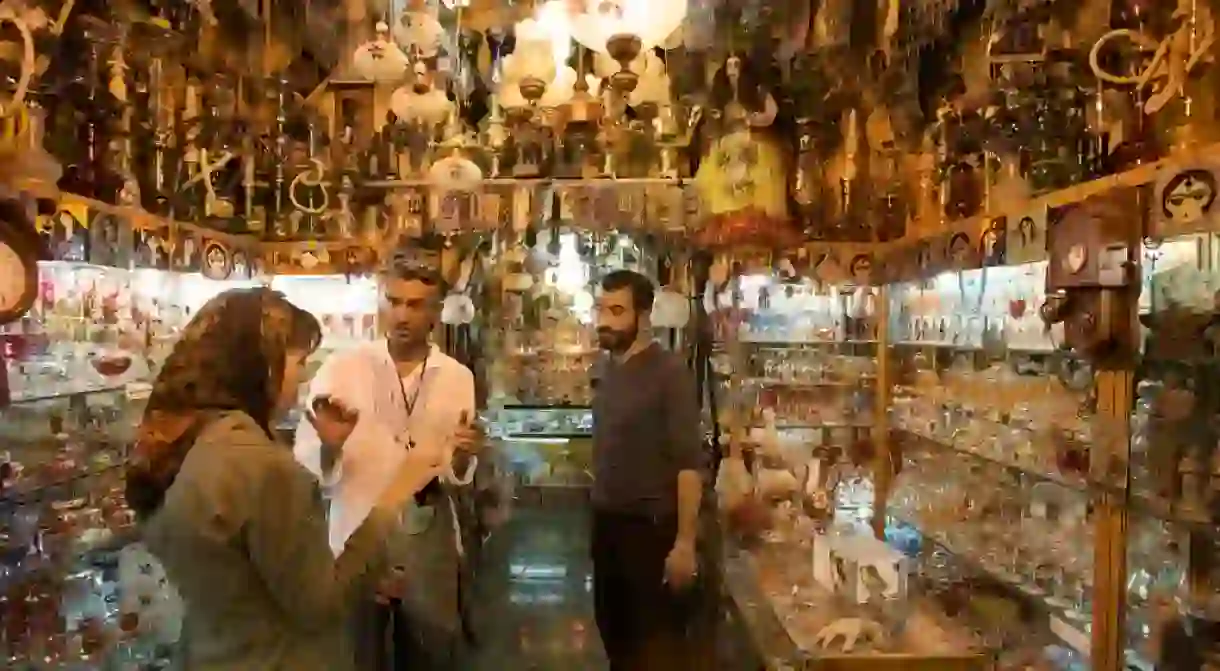10 Unique Souvenirs to Buy in Iran

Iranian souvenirs are artisanal handicrafts unique to each city and made with lots of love. While walking through the bazaars is a feast for the eyes, it can become overwhelming if you don’t know what to look for. Check out our list of the best souvenirs to buy from Iran to bring a part of this unforgettable country back home with you.
Handmade Cloths
Handmade cloths in Iran vary depending on the city you are visiting. Ghalamkâri is the traditional textile printing of Esfahan which uses wooden stamps to press floral, geometric, and arabesque patterns into cotton cloths. Native to Kerman is pateh, a naturally dyed, hand-stitched decorative cloth made of wool. Meanwhile, Yazd is famous for its termeh, a luxurious, hand-woven silk fabric with fine threads of gold woven in. Termeh in particular is also made into different forms such as purses, shoes, tablecloths, and jewelry pouches.

Giveh
Giveh are traditional footwear common in the mountainous areas of the Kermanshah province. These espadrille-like handmade shoes consist of a leather sole (though rubber is also available) and a white woven cotton upper. Especially practical during the summer months due to their breathable fabric, Giveh have made a comeback in recent years thanks to local artists giving them a modern twist to appeal to the younger generation’s leisurely style. Upgrade your wardrobe with this statement piece that is sure to turn heads and have people asking where you got them.

Sweets, nuts, and spices for the foodie
Those who have a sweet tooth will feel an absolute need to bring back the buttery brittle, sohan, from Qom or the Persian nougat, gaz, from Esfahan. As a leader in the pistachio market, what better place than Iran to pick up the real deal? Try the ones roasted in lemon juice for a kick of tangy flavor. To add some exotic flavors to your cooking, look out for saffron. This “red gold”, as it’s often called, is used extensively in Persian cooking, and the hub of the industry is Mashhad. Another essential ingredient particularly for Iranian desserts is rosewater from the fragrant Mohammadi roses, the best of which comes from Kashan.

Home furnishings
It goes without saying that buying a Persian rug means scoring the ultimate souvenir. Even if you aren’t ready to take the plunge and splurge on a pure silk or wool-silk blend rug, you could shop for something smaller and more affordable like a kilim, or try a wool ottoman or pillow covers in tribal patterns which can easily be flattened in your suitcase and filled at home. Be sure to check out our guide to buying the perfect Persian carpet in case you need a little more help.

Minakari
Once you visit Esfahan, you realize that it’s a city concerned with aesthetic beauty, so it’s no wonder that many handicrafts come from there. One of the most famous is minâkâri, or enamelwork. Copper surfaces are traditionally decorated by a fine-haired brush with miniature birds and floral patterns on a background which is most commonly azure, though green and red can also be found. Minâkâri comes in plates, vases, chalices, and other decorative items, and it’s not uncommon to see artists hard at work creating new pieces in the old section of Esfahan’s bazaar.

Khâtamkâri
Khâtamkâri is the Persian art of marquetry. Fine pieces of wood, bone, and metal are inlaid to create all kinds of decorative objects including jewelry boxes, picture frames, backgammon boards, and others. While some are pure khâtamkâri, others have miniatures painted on the top, another typical form of Iranian art. These make great gifts for friends although you’ll probably want one for yourself, too.

Ceramics and pottery
A visit to the National Museum of Iran will tell you that pottery has had a long history in the country and dates back even before the Persian Empire. These days, cities like Lalejin, Meybod, and Natanz keep this age-old tradition alive with hand-painted dishes and mugs. Decorative objects made in typical Persian forms like pomegranates, horses, and birds will be the ones that truly remind you of Iran.

Tea set
Iranians are big tea drinkers, so it’s not unusual to find several teapots and sets of glasses for every occasion in any given household. A set of saucers, tea glasses, and teapot featuring the so-called image of Shah Abbas, makes for great use or just decoration. Make sure you get it in red for extra authenticity. If you have extra room in your suitcase, you could even bring back the samovar to brew tea in true Iranian fashion!

Ghalamzani
As you wind your way through Esfahan’s bazaar towards the sounds of steady banging, artists engaging in metal engraving will come into view. The art of ghalamzani involves skilled craftsmen embossing gold, silver, bronze, and copper to create elaborate designs on trays, plates, vases, and silverware. What could make this souvenir even more memorable is that you might pick up a personalized piece that the artist just finished.

Turquoise
The city of Neyshabur in the northwestern part of Iran is not just famous for the poet Omar Khayyam, but also for the purity of its turquoise. Just outside this town are mines from which this precious stone is extracted, then shaved and shaped in to pendants, rings, and other jewelry. Turquoise is also used in art forms such as firoozeh koob, the art of hammering small pieces of turquoise into copper. In Persian culture, turquoise is said to have healing properties, detoxify the body, and protect against the evil eye. Shades of blue are omnipresent in Iranian mosques and palaces, and turquoise is a way to take it back home.














